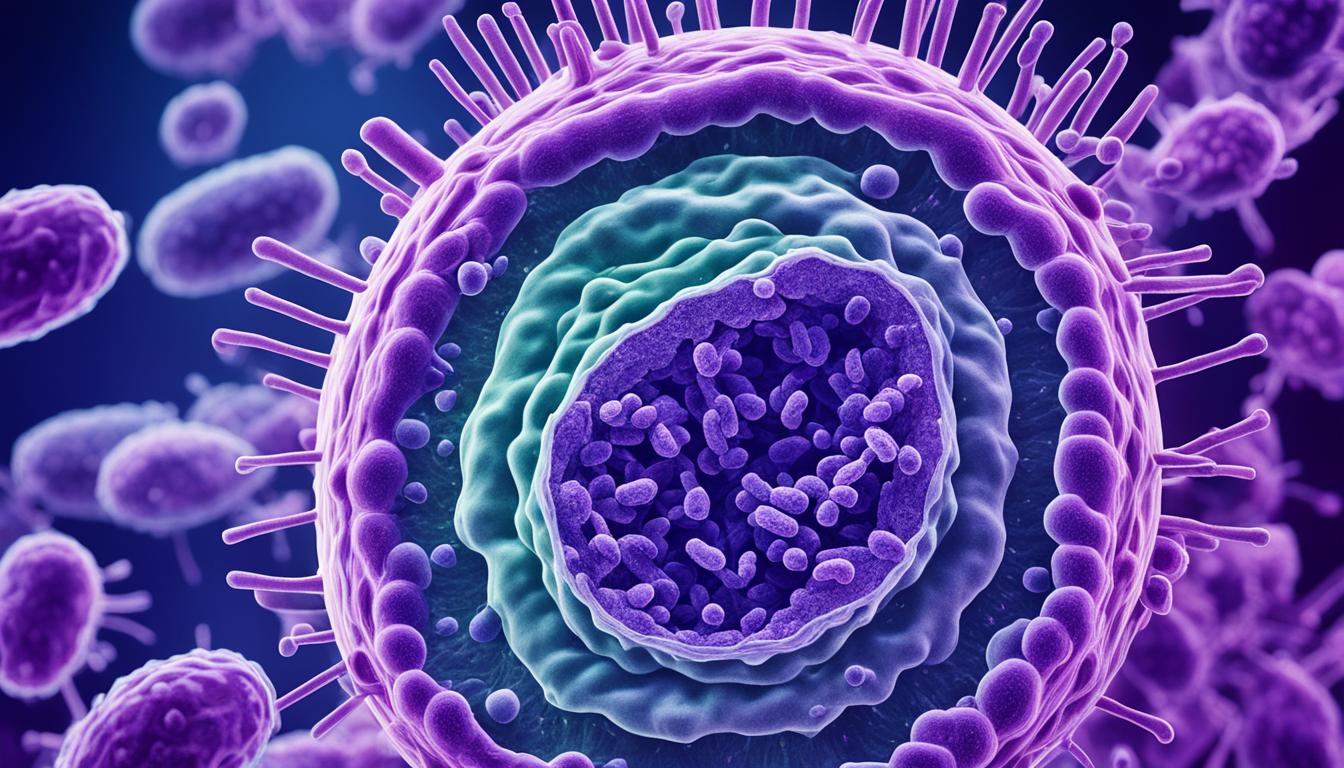Diphtheria is a serious illness caused by the bacteria Corynebacterium. It mainly spreads through respiratory secretions or from skin wounds. If not treated, it can cause severe issues and death.
The main cause of diphtheria is the bacteria Corynebacterium diphtheriae. This disease can appear in different parts of the body. This includes the upper respiratory tract, skin, eyes, and genitals.
It spreads through breathing in bacteria from infected people or touching their wounds. This illness peaks in cold months. Both sick and healthy carriers can spread it. Kids under 15 face the highest risk.
Symptoms can include a sore throat, tiredness, and swollen glands. To diagnose diphtheria, doctors look at these signs and known risks. Treatment involves using diphtheria antitoxin and antibiotics to fight the bacteria.
Stem cell therapy, a new treatment, is showing hope in fighting diphtheria.
Key Takeaways:
- Diphtheria is a serious illness caused by the bacteria Corynebacterium diphtheriae
- The disease mainly spreads through coughs, sneezes, or from skin cuts
- Left untreated, diphtheria can result in severe problems and death
- Those under 15 are at the highest risk
- Doctors diagnose diphtheria by looking at symptoms and risks
Causes and Transmission of Diphtheria
Diphtheria comes from a bacterium called Corynebacterium diphtheriae. It includes types like Gravis, Intermedius, and Mitis, but Mitis is usually less harmful. The sickness spreads mainly through breathing in the same air as an infected person or touching their skin sores.
Sick people and those without symptoms can have the bacteria in their throat. About 5% of people who seem healthy might carry it. This hidden spreading helps diphtheria move from one person to another.
You can get diphtheria if you touch someone’s mouth fluids or skin sores. Also, breathing in tiny droplets from the air when an infected person coughs or sneezes might infect you.
The sickness spreads more in cold months. Being indoors and close to others, especially when they have respiratory issues, increases the risk.
The diphtheria bacteria can live on objects for hours. This makes it important to wash hands regularly. Keeping clean helps stop the sickness from spreading.
Prevention of Diphtheria Transmission
Vaccination is the key to stopping diphtheria from spreading. Children usually get the vaccine as a part of their regular shots. This helps build strong protection against the bacteria.
Everyone getting vaccinated, keeping hands clean, and staying away from sick people can prevent diphtheria. It’s crucial to avoid being close to those who are infected or touching places they have touched.
The image below illustrates the transmission of diphtheria and the importance of preventive measures:
Clinical Manifestations and Complications
Diphtheria shows different symptoms based on where it infects. When it starts in the throat, you might feel a sore throat, tiredness, and have a mild fever. Later, a pseudomembrane can form in the throat, making it hard to breathe. It might spread to other areas too.
The most common type affects the throat and tonsils. It shows up with a pseudomembrane on the tonsils. This can cause trouble breathing and may lead to problems like airway blockage or lung issues. Quick treatment and isolation are key to stop this type from spreading further.
Malignant diphtheria is a serious kind that spreads and affects the whole throat. It causes big health issues and can be life-threatening. People with this type may feel very tired, breathe fast, have a lot of swelling, and find it hard to swallow.
Diphtheria can also lead to serious complications like heart inflammation, damage to the nerves or kidneys, and problems with the nervous system. These issues can be deadly and need fast medical help.
Respiratory Diphtheria and Oropharyngeal Diphtheria
Respiratory diphtheria targets the respiratory system, causing problems in the throat and airways. The pseudomembrane in the throat can block the airway and cause breathing issues. Oropharyngeal diphtheria, however, affects mainly the tonsils.
- Respiratory diphtheria symptoms:
- Sore throat
- Malaise
- Low-grade fever
- Cough
- Difficulty breathing
- Oropharyngeal diphtheria symptoms:
- Pseudomembrane on the tonsils
- Severe sore throat
- Difficulty swallowing
- Swollen lymph nodes in the neck
Malignant Diphtheria and Complications
Malignant diphtheria is a dangerous type of the disease. It spreads throughout the throat and causes widespread problems. A fast and strong response is important to treat this severe form of the illness.
- Malignant diphtheria symptoms:
- Extreme fatigue
- Rapid breathing
- Severe swelling of the throat and neck
- Difficulty swallowing and speaking
- Signs of systemic toxicity
- Diphtheria complications:
- Myocarditis (inflammation of the heart muscle)
- Neurotoxicity (damage to the nervous system)
- Peripheral neuritis (inflammation of peripheral nerves)
- Renal failure (kidney damage)
Knowing the symptoms early and getting the right medical help can greatly increase the chance of a good recovery.
Advances in Diphtheria Treatment: Stem Cell Therapy
Stem cell therapy is becoming a big hope for better treating diphtheria. This new approach uses stem cells to fix the harm diphtheria causes in the body.
This kind of therapy speeds up healing, lowers risks, and boosts the recovery of diphtheria patients. Stem cells are special; they can change into different kinds of cells. This makes them perfect for fixing disease-related damage.
Even though stem cell therapy seems very promising, more studies and tests are needed. They help us know how well and how safe this treatment is for diphtheria. Many scientists and doctors are busy with these studies, aiming to make the best use of stem cells.
The world of regenerative medicine is advancing fast, showing great hope in changing how we treat diphtheria. With more research, we aim to fully unleash the power of stem cells. Our target is to offer safe and effective treatments for this serious illness.

